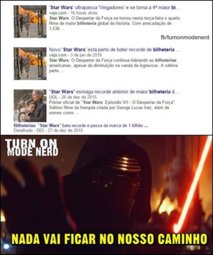-
Caro Visitante, por que não gastar alguns segundos e criar uma Conta no Fórum Valinor? Desta forma, além de não ver este aviso novamente, poderá participar de nossa comunidade, inserir suas opiniões e sugestões, fazendo parte deste que é um maiores Fóruns de Discussão do Brasil! Aproveite e cadastre-se já!
Você está usando um navegador desatualizado. Ele poderá não mostrar corretamente este fórum.
Você deve atualizá-lo ou utilizar um navegador alternativo.
Você deve atualizá-lo ou utilizar um navegador alternativo.
Star Wars: Episódio VII - O Despertar da Força (2015)
Ecthelion
Mad
Box Office: 'Star Wars: Force Awakens' Tops 'Avatar' to Become No. 1 Film of All Time in North America
http://www.hollywoodreporter.com/news/box-office-star-wars-force-852274
http://www.hollywoodreporter.com/news/box-office-star-wars-force-852274
Grimnir
Well-Known Member
Vc pode ver na hora que parece que ele acorda ainda bem no inicio o Ren para e olha para ele. Logo apos o mestre fala que ouve um despertar na força. Ainda a Rey n tinha mostrado a força nela. Eu acho que o Finn tem alguma coisa a mais !
(spoilers)
eu não acho que "o despertar da força" seja assim tão literal, no sentido da rey começar a usar (ou o finn, supondo que a manipulação do sabre de alguma forma tenha envolvido o uso da força). acho que é mais no encontro da rey com o sabre de luke com todas aquelas visões e vozes de jedis e blablabla (só não lembro se isso rolou antes ou depois da conversa do ren com o snoke, hehe).
Como comentei no outro tópico, a cena em que Snoke fala sobre o despertar da Força é depois que Rey e Finn fogem do cargueiro com Han Solo e Chewie.
O @Otavio Magin lembrou bem: Logo no começo do filme Kylo Ren parece sentir algo de estranho em Finn. Pode não ser nada sobre a Força, Kylo Ren pode simplesmente ter sentido medo do soldado e se virou para identificá-lo. Por outro lado, o escape mental de Finn do condicionamento dos stormtroopers pode ter alguma relação com o despertar da Força. Além disso, antes da cena sobre o despertar da Força, vemos o desempenho surpreendente de Rey e Finn na Falcon - ambos ficam surpresos com as habilidades que usaram, como se uma intuição mais forte estivesse guiando suas ações. De novo, pode não ser nada, mas sei lá.
Já foi dito que a Força entrou em hibernação depois dos acontecimentos na Academia Jedi de Luke e que o seu despertar coincidiu com a aventura de Rey e Finn.
Since the disappearance of Luke Skywalker and the shattering of his fledgling Jedi following, the cosmic Force has lain dormant, seemingly quieted to those able to sense its presence. The adventures of Rey and Finn on Jakku coincide with a turbulence in the cosmic Force, a sudden ripple indicating the awakening of newfound ability. With the Jedi and their records vanished, few—other than Kylo Ren and his mysterious master—are able to appreciate the occurrence.
Fonte.
Então é aquela coisa: As habilidades de Rey (e talvez de Finn) podem não ser o despertar em si, mas podem, por outro lado, ter aflorado como consequência do despertar da Força. O que causou o despertar? Nobody knows.
Última edição:
Sentinela de Gondor
Ranger
Pra quem , como eu, esperava uma Versão estendida...
Star Wars 7 | Blu-ray e DVD terão cenas deletadas, mas não versão estendida
Star Wars 7 | Blu-ray e DVD terão cenas deletadas, mas não versão estendida
Bruce Torres
Let's be alone together.
Ainda bem.
Bruce Torres
Let's be alone together.
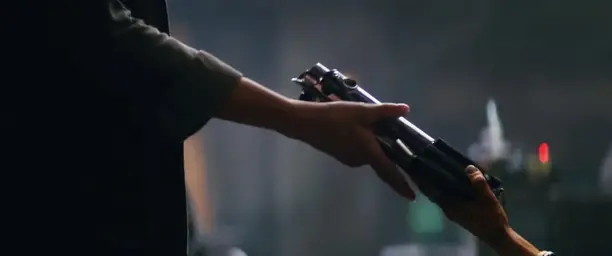
STAR WARS MYTHOLOGY 3.0
by Omer M. Mozaffar
January 13, 2016
While “Star Wars: Episode VII - The Force Awakens” picks up on the "Star Wars" narrative by extending the story forward while looking back to pay homage, it also expands upon its folklore. We have new and old characters, new and old gadgets, but we do not learn as much about the Force as we do about the evolution of its mythology. Some of the material would please Joseph Campbell. Some innovates.
The narrative frames the battle between Jedis and Sith (now, the First Order) as the battle between the two sides of the Force. I never understood what “balance” meant in the films, if the goal was to eradicate one side of the Force. Nevertheless, that contrast between light and dark finds a twist in "The Force Awakens" (TFA). The two Death Stars of the Original Trilogy (OT) dwelled in darkness. The Star Killer base is the galaxy’s darkest device ever, designed to destroy multiple worlds at once. Yet, it gains its power from the sun, the source of the light.
With such a stage as a full galaxy, all the "Star Wars" films feel large. Mythology comes from our aspirations to reach beyond our selves into a larger world. Medieval European Churches were colossal as an expression of the greatness of the Divine, against the smallness of the believer. The believer walks into the large sanctuary and submits. Today, space exploration takes on the same role, with photos of the Universe illustrating its incomprehensible size, illustrating our irrelevance in the cosmos. Paleontology does the same, reconstructing giant dinosaurs.
The "Star Wars" films express size with the Empire’s fleet, representing its might. The primary expression of their strength, however, was in that Death Star. In the Prequels, the Death Star was a concept. In the Original Trilogy, the first Death Star was the most powerful weapon, until it was overtaken by the larger Death Star II, which was overtaken in TFA by the colossal Star Killer base.
But, that is half the mythology; the other half is that material size does not reflect true might. The ongoing battle between the light and dark sides of the Force mask their implicit battle between the world of principle and the world of power, with principle winning. In “The Empire Strikes Back,” Luke cannot imagine levitating a large X-Wing Fighter, yet Yoda, himself a fraction of Luke’s size, accomplishes it.
This point plays out, perhaps unplanned, in TFA’s climax. The destruction of the giant Star Killer base, in theory the largest explosion in the galaxy’s history, feels like an afterthought, compared to the drama of not only Kylo Ren’s murder of Han Solo, but even his lightsaber duel against Finn and Rey. Even R2-D2’s rebirth captures more attention.
The reason, of course, for the greater importance we give to Luke Skywalker’s meeting with Rey, or Han Solo’s death is that we have had decades of relationships with them. Seeing them again was a moment of nostalgia, which leads us to another element of the new mythology.
Through these seven films we shift from prophecy, to legend. Prophecies compel us not only to look forward, but when they speak of success or conquest, they inspire us to coerce the present into the future. We see this in our planet today, with religious groups doing whatever it takes—including violating their own religious principles—to strong-arm the arrival of their savior.
Legend, in contrast, is an admiring view into the past, and a hopeful, adventurous peek into the future. In the prequels, the Chosen One was to bring balance to the Force, and the Jedi wagered on the wrong candidate. In the OT, Luke followed legends of the Clone Wars, hoping to also be a hero, not knowing he himself is the fulfillment of prophecy.
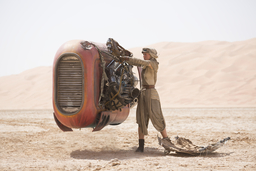
In TFA, however, the prophecies have been fulfilled, and we now live in a world—especially in the planet Jakku—of artifacts. When we first meet Rey (Daisy Ridley) she is a scavenger, an archeologist, digging through the fossils of fallen star destroyers. Some of her explorations involve finding scrap parts to trade for food. Other discoveries, like helmets of forgotten rebel warriors, take her to imaginary worlds that may have existed. Rey and Finn (John Boyega) now speak of the Jedi, Luke Skywalker, and Han Solo as heroes from an enchanted era long gone, almost forgotten, perhaps fictional, until they meet Han Solo himself. The difference now, however, is that we have no prophecies, but hope remains.
In Rey, we find another variation on the Star Wars tradition: female mentors. Though there were female Jedi, all the key Jedi in the films thus far had been males, all the mentors were males. She gets discovered by potential mentors, but she rejects. Unkar Plutt is her boss and she bucks him. Finn offers her a hand, and she rejects him. Han offers her a job and she declines him. She does, however, listen to the females: Maz Kanata (Lupita Nyong’o) and General Leia.
Some of the influence might be from the Disney princesses. Rey joins Snow White, Cinderella, Sleeping Beauty, Ariel, Belle, Jasmine, Pocahontas, Mulan, Tiana, Rapunzel, Merida, and Elsa. The formula for the modern princesses (Ariel through Elsa) is that they are young women prevented physically, institutionally, socially from finding fulfillment. If the parents are present—and usually they are not—one (often the father) is a dimwit or a tyrant. The princess must break her society’s rules in order to find her destiny, and she succeeds.
On the other side, in Kylo Ren, we do not yet know his desires behind his mask, except that he longs to fulfill his grandfather’s mission. We do, however, find something in common between him, Finn, and to lesser degree Rey and Maz: unmasking. In the prequels, the villains—Darth Sidious/Palpatine, Dooku, Grievous—hide until they have to get ferocious. In the OT, heroes wear masks when they need to free someone, either Luke and Han seeking to rescue Leia from the Death Star, or Leia seeking to rescue Han from Jabba the Hut. The final mask—Darth Vader’s—comes off after Luke saves him from the dark side, and it kills him.
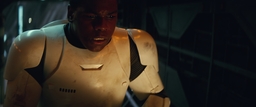
In TFA, however, masks come off, revealing humanity. Finn removes his Stormtrooper helmet after he could not follow orders to kill villagers. Kylo Ren reveals his face a few times, expressing his struggles. Still, after the physical masks drop off, they wear metaphorical masks. Meaning, both still resort to lying to achieve their goals. Finn lies to Rey, BB-8, Han, Chewie and Maz to stay alive and escape the First Order. Ren lies to Han to kill him, and perhaps Snoke, to keep his trust.
Maz, however, removes her spectacles for the opposite purpose. While Finn and Ren reveal themselves, she does so to see more clearly into the eyes of her subjects. She has seen the past, and has glimpses into the future.
In, the end, however, the newest change we see from the prequels and OT of the yesteryear to TFA is the shift from the baton to the boomerang. The Force Awakens is the hand-off of the Star Wars commodity from George Lucas to Disney, from George Lucas to J.J. Abrams. Within the narrative, one boomerang is the lightsaber—that weapon of chivalry, honor, and civility—that was owned by Anakin, then stored by Obi Wan Kenobi, then owned by Luke Skywalker, then stored by Maz Kanata, then given to Rey, to give back to Luke. Or, it is that light speeder, the Millennium Falcon—that freighter used to steal and smuggle—that Lando gambled and lost to Han, which was stolen by Ducain, then by the Irving Boys, then by Unkar Plutt, then by Rey and reclaimed by Han. We wonder then, what will happen next to that blue lightsaber and to that spaceship.
We are all waiting to see where things go in Episodes VIII and IX, as well as the other films. It is fair to assume that we will see more new and old.
Fonte: http://www.rogerebert.com/far-flung-correspondents/star-wars-mythology-30
Bruce Torres
Let's be alone together.
dermeister
Ent cara-de-pau
Pela data e hora, tem uma chance considerável desta ser uma versão (ainda) não bloqueada do mesmo vídeo que o @Bruce Torres postou: esse VFX mostra bem ao George Lucas como usar CG como ferramenta para contar uma história e não para ficar na vitrine.
Ana Lovejoy
Administrador
li hoje um artigo falando que o pãozinho que a rey faz no começo do filme não é cgi  assim, tb não é um pão que cresce magicamente, foi usando um sistema para fazer o pão inflar e outro para puxar a água do prato ao mesmo tempo, mas mesmo assim, imagina o tamanho do trampo. é o tipo de coisa que mostrar que a computação gráfica ficou só para o que não tinha outro modo de se fazer.
assim, tb não é um pão que cresce magicamente, foi usando um sistema para fazer o pão inflar e outro para puxar a água do prato ao mesmo tempo, mas mesmo assim, imagina o tamanho do trampo. é o tipo de coisa que mostrar que a computação gráfica ficou só para o que não tinha outro modo de se fazer.
Morfindel Werwulf Rúnarmo
Geofísico entende de terremoto
Uma coisa que achei bem legal nesse filme foi aquela cena
Mostra pra nós que eles não são seres sem importância. Serviu pra vermos eles como humanos tanto quanto os outros personagens.
Os stormtroppers são soldados treinados desde a infância pra serem assassinos? Eu demitiria o responsável pelo treinamento deles. Pqp! Como são ruins de pontaria!
em que o stormtrooper ferido coloca a mão ensaguentada na máscara de Finn
Mostra pra nós que eles não são seres sem importância. Serviu pra vermos eles como humanos tanto quanto os outros personagens.
Os stormtroppers são soldados treinados desde a infância pra serem assassinos? Eu demitiria o responsável pelo treinamento deles. Pqp! Como são ruins de pontaria!
Galford Strife
Jedi Master
Uma coisa que achei bem legal nesse filme foi aquela cenaem que o stormtrooper ferido coloca a mão ensaguentada na máscara de Finn
Mostra pra nós que eles não são seres sem importância. Serviu pra vermos eles como humanos tanto quanto os outros personagens.
Os stormtroppers são soldados treinados desde a infância pra serem assassinos? Eu demitiria o responsável pelo treinamento deles. Pqp! Como são ruins de pontaria!
Nos filmes antigos eles eram clones, agora que está sendo assim, e no VII eles estão mto melhores do que antes kkkk
Bruce Torres
Let's be alone together.
Nos filmes antigos eles eram clones, agora que está sendo assim, e no VII eles estão mto melhores do que antes kkkk
Eu sei que os soldados das prequels são clones, mas acho que eles já não são mais na primeira trilogia - vide que o Luke até menciona que Biggs LightEtc foi pra Academia Imperial.
Galford Strife
Jedi Master
Eu sei que os soldados das prequels são clones, mas acho que eles já não são mais na primeira trilogia - vide que o Luke até menciona que Biggs LightEtc foi pra Academia Imperial.
Verdade... tinha esquecido desse detalhe, mas não muda o fato de eles estarem melhorzinhos no ep VII.
Bruce Torres
Let's be alone together.
E, olha. Quem achou decepcionante as lutas de lightsabers, é porque é fã dos prequels, hein? Preferiam ver dois retardados com ataque epilético girando o sabre de luz igual uns bailarinos, sem nunca nem tentar um golpe em ponto vital? Credo. Gostei de mais do Force Awakens ter voltado às origens, e ter feito combates bem mais pesados mesmo.
Estilo dos prequels:
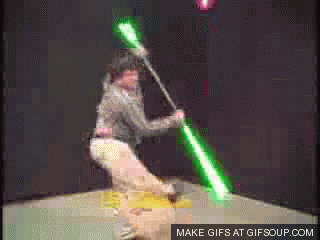
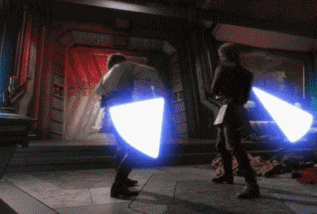
Eu não achei decepcionantes os duelos do novo filme não. Mas também dizer que os duelos das prequels são "dois retardados com ataques epiléticos" é exagero demais. Temos que lembrar que os Jedi e Sith na época de Velha República estavam no auge da forma e do uso da Força. Então é normal que usassem todos os recursos. Para mim, o melhor duelo de toda a saga até hoje foi Darth Maul x Qui-Gon e Obi-Wan, não só pelas cenas em si, mas também pelo significado daquela luta: um reencontro de Jedi e Sith depois de mil anos. E, sinceramente, me arrisco a dizer que a sequência do Maul e Obi-Wan, depois da derrota do Qui-Gon é sensacional, talvez um dos melhores duelos de espadas já vistos no cinema. E o Maul tenta atingir o Obi-Wan em partes vitais sim, só que o Jedi era fera em bloquear os ataques (em um dos momentos da luta, inclusive, Maul tenta acertá-lo com o sabre nas costas, mas Obi-Wan bloqueia).
Você está julgando as "piruetas" pelo Yoda e o duelo Anakin x Obi-Wan. O Yoda era perfeitamente justificável: o cara tinha 66 cm de altura, então, para um duelo eficaz, era natural que ele usasse a Força para dar saltos, inclusive para surpreender o adversário. E os exageros nas espadas só vi na primeira parte do duelo Anakin x Obi-Wan, o que mudou muito quando foram duelar próximo à lava.
E outra: nem todo Jedi/Sith era "saltador" assim. Não vi Mace Windu, Qui-Gon ou Dooku fazendo isso. Lembremos que havia 7 formas de combate de sabres de luz, o que pode fazer uma baita diferença de estilos.
Ecthelion
Mad
Que eu saiba o auge aconteceu uns 5 mil anos antes, não?!Temos que lembrar que os Jedi e Sith na época de Velha República estavam no auge da forma e do uso da Força.
Elriowiel Aranel
Usuário
Que eu saiba o auge aconteceu uns 5 mil anos antes, não?!
NÃO
5 mil anos atrás era o INÍCIO da Ordem Jedi, eram os Cavaleiros da Velha República.
Ainda estavam aprendendo a lidar com a Força e a Ordem Jedi ainda não era uma instituição bem organizada, com regras fixas e tal
Por exemplo: os Jedi podiam casar, podiam iniciar treinamento já adultos (vide Nomi Surinder) e um mestre podia ter vários padawans. Aliás, nem havia uma hierarquia tão bem estabelecida.
Os Jedi do Ep I estavam no AUGE.
Nos Ep II (10 anos depois) e Ep III estão em queda, pois os Sith começam exercer influência na Força, nublando a percepção dos Jedi e instigando a ambição em alguns, além de colocá-los uns contra os outros (vide o caso de tremenda injustiça da Ordem com a Ahsoka).
Não vejo qual o problema de ser fã da Nova Trilogia. Sou tão fã da Nova Trilogia quanto da Trilogia Clássica.
E odiei o Ep VII, não passa de um fan-film ridículo pra mim.
Sim, eu poderia passar um dia inteiro aqui destrinchando cada argumento que tenho pra cada afirmação minha acima, como aliás fiz nos últimos meses em outros lugares... Mas to tão cansada, rs.
Nos filmes antigos eles eram clones, agora que está sendo assim, e no VII eles estão mto melhores do que antes kkkk
NÃO
Trilogia Clássica: eram recrutas
Nova Trilogia: clones (eram CloneTroppers, não Stormtroppers)
Fan-Film do Abrams: crianças sequestradas
Grimnir
Well-Known Member
E odiei o Ep VII, não passa de um fan-film ridículo pra mim.
Desenvolve aí?

Tópicos similares
- Respostas
- 0
- Visualizações
- 98
- Respostas
- 0
- Visualizações
- 304
- Respostas
- 12
- Visualizações
- 1K
Compartilhar:

